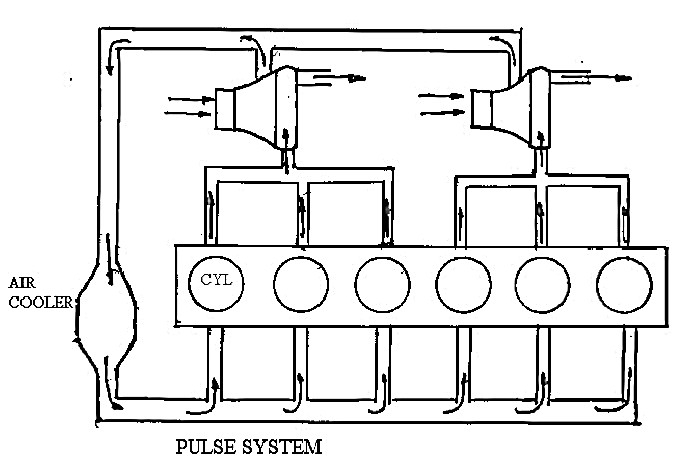TURBOCHARGING
Turbocharger uses exhaust flow from engine to spin a turbine which in turn drives a centrifugal compressor. Thus it does not draw upon the engine’s power.
Constant Pressure System Turbocharging
Exhaust gas from all cylinders into a common large manifold where pulse energy is largely dissipated. The gas flow will steady rather than intermittent and at a constant pressure at turbine inlet.
Exhaust gas from all cylinders into a common large manifold where pulse energy is largely dissipated. The gas flow will steady rather than intermittent and at a constant pressure at turbine inlet.
Turbocharger Arrangement in Constant Pressure System
No exhaust grouping.
Exhaust gases enter into large common
manifold and then to turbine.
Firing order not considered.
Advantages and Disadvantages for Constant Pressure System
Advantages
- Good performance in high load (Efficient when Bmep is above 8 bar).
- More suitable for high output engine.
- There is no need to group the cylinders exhaust into multiple of three. (Simple piping system).
- No exhaust grouping.
- High turbine efficiency due to steady flow of exhaust.
- The work transfer at the turbine wheel is smooth.
- Reduction in SFOC (Specific Fuel Oil Consumption) of 5% – 7%
Disadvantages
- When running at reduced speed and starting up low available energy at turbine.Thus it supplies inadequately air quantity of the scavenge pressure.
- Necessary for efficient scavenging and combustion.
- It require scavenge assistant (Auxiliary Blowers).
- Poor response in changing load.
Pulse System of Turbocharging.
- Makes full use of the higher pressure and temperature of the exhaust gas during the blow down period.
- While rapidly opening the exhaust valves, exhaust gas leave the cylinder at high velocity as pressure energy is converted into kinetic energy to create the pressure wave or pulse in exhaust.
- These pressure waves or pulses are lead directly to the turbocharger.
- Exhaust pipe, so constructed in small diameter, is quickly pressurized and boosted up to form pressure pulse or wave.
- Pressure waves reach to turbine nozzles and further expansion takes place.
Turbocharger Arrangement in Pulse System
- Interference exists between exhausting and scavenging among cylinders.
- To prevent this, cylinders are grouped relatively with connections to two or more exhaust pipes.
- Pipes are arranged, in small diameter to boost up pressure pulse and in short, straight length to prevent energy loss.
- Number of exhaust branch depends upon firing order, number of cylinders and turbocharger design.
Advantages and Disadvantages of Pulse System
Advantages
- At low load and low speed it is more efficient (Still efficient when Bmep is < 8 bar).
- No need assistant of scavenge pump and blower at any load change.
- It is highly response to change engine condition giving good performance of all speed of engines.
- High available energy at turbine.
- Good turbocharger acceleration.
Disadvantages
- The exhaust grouping is complicated.
- Different sizes of exhaust pipes are needed for spare.
TWO STAGE
High pressure exhaust from one cylinder would pass back into another cylinder during the low pressure scavenging period thus adversely effecting the combustion efficiency.
This method involves use of two turbochargers of different sizes in series. Eg. A high pressure stage operating on pulse system and low pressure stage on constant pressure system.
It is used for diesel engines requiring very high degree of supercharging which cannot be obtained by single stage turbocharger.
Rapid change in load : Fluctuations due to rough weather, will cause vibrations in air mass flow rate due to change in engine speed.
Insufficient fuel supply : This can cause the engine speed to vary due to fuel starvation. produces similar result as above.
Fault in fuel system : Due to incorrect setting, timing of fuel pumps, costing fuel barrels, results in different combustion conditions for individual cylinders this can lead to variation in turbochargers speeds and air mass flow rates (pulse system).
Restriction of scavenge passages : Blockage of air filters, will cause pressure ratio across compressor to increase and reduce air flow rates. Operating line of turbocharger moves closer to the surge line.
Narrowed exhaust gas passages (After turbo) : An extreme increase in resistance of the exhaust gas discharge passage will result in the reduction of air flow through the compressor.
Engine operation at overloads : The engine speed is maintained constant of water fouling of the hull or damage to the property of turbocharger speed will increase without increase in air mass flow Reduction in surge margin.
Failure of turbine blade, nozzle,diffuser : Fouling or damage to the above will result in increased resistance to the gas flow and reduce air flow to the engine.
REASONS FOR TURBOCHARGER REDUCED AIR DELIVERY
- Drop in ambient pressure.
- Reduction in engine load.
- Change in fuel quality.
- Change in engine timing.
- Fouling of air intake filter.
- Fouling of inducer/diffuser.
- Fouling of air side of charger air cooler.
- Fouling of exhaust ports and pipe work.
- Fouling of protection grid.
- Fouling of nozzle ring, turbine blades.
- Fouling of exhaust gas boiler.
- Fouling of silencer.
- Mechanical damage to rotor.
- Casing or piping leaks.
TURBOCHARGER VIBRATION
Gradual increase in vibration could be due to:
- On damping spring in roller bearings Ineffective mounting bolts.
- Uneven fouling.
- Failure of damping wire.
Vibration after overhaul could be due to :
- Incomplete cleaning.
- Misalignment of rotating parts.
Sudden increase in vibration could be due to :
- Washing removing only parts of the rotor dirt.
- Blade damage from mechanical item striking rotor blades.
- Bearing failure.
- Water striking rotor from casing leak.
RUNNING WITH DAMAGE






No comments